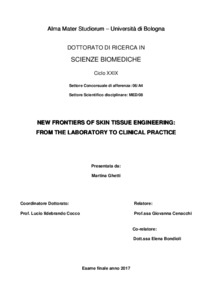Ghetti, Martina
(2017)
New Frontiers of Skin Tissue Engineering: from the Laboratory to Clinical Practice, [Dissertation thesis], Alma Mater Studiorum Università di Bologna.
Dottorato di ricerca in
Scienze biomediche, 29 Ciclo. DOI 10.6092/unibo/amsdottorato/8061.
Documenti full-text disponibili:
![[img]](http://amsdottorato.unibo.it/8061/1.hassmallThumbnailVersion/PhD%20thesis%20Martina%20Ghetti.pdf)  Anteprima |
|
Documento PDF (English)
- Richiede un lettore di PDF come Xpdf o Adobe Acrobat Reader
Disponibile con Licenza: Salvo eventuali più ampie autorizzazioni dell'autore, la tesi può essere liberamente consultata e può essere effettuato il salvataggio e la stampa di una copia per fini strettamente personali di studio, di ricerca e di insegnamento, con espresso divieto di qualunque utilizzo direttamente o indirettamente commerciale. Ogni altro diritto sul materiale è riservato.
Download (2MB)
| Anteprima
|
Abstract
This thesis is focused on the key role of extracellular matrix in skin tissue engineering. Firstly, I presented three dimensional structures derived through the physiological secretion of extracellular matrix (ECM), that may be a bioinspired scaffold. I performed a biological characterization of cell-assembled ECMs from three different sub-populations of skin fibroblasts; papillary fibroblasts (Pfi), reticular fibroblasts (Rfi), and dermal papilla fibroblasts (DPfi). Fibroblast sub-populations were cultured with ascorbic acid to promote cell-assembled matrix production for 10 days. Cells were removed and the remaining matrices were characterized. I found that the ECM assembled by Pfi exhibited randomly oriented fibers, associated with highest interfibrillar space, reflecting ECM characteristics which are physiologically present within the papillary dermis. Mass spectrometry followed by immunofluorescence analysis showed that Thrombospondin is preferentially expressed within the DPfi ECM. In another experiment, keratinocytes were seeded on the top of cell depleted ECMs to generate epidermal skin constructs. I found that epidermal constructs grown on DPfi or Pfi matrices exhibited normal basement membrane formation, while Rfi matrices were unable to support membrane formation. Thus, inspiration should be taken from these different ECMs, to design therapeutic biomaterials in skin engineering applications. In the second part, I focused on human decellularized matrix for soft tissue repair and I investigated the biological interaction post-implant of this scaffold. The aims of this second part were to show the clinical results after the application of human decellularized matrix in patients suffering from abdominal hernia and to evaluate the response one year post implant, through morphological analysis of biopsy specimens. Clinical results showed that all the patients revealed a well tolerability of human decellularized matrix. Post-implant morphological results showed cellular repopulation, neo-angiogenesis, minimal inflammatory response and a well-organized collagen matrix in all biopsies. This scaffold can be considered a safe product to treat large abdominal defects.
Abstract
This thesis is focused on the key role of extracellular matrix in skin tissue engineering. Firstly, I presented three dimensional structures derived through the physiological secretion of extracellular matrix (ECM), that may be a bioinspired scaffold. I performed a biological characterization of cell-assembled ECMs from three different sub-populations of skin fibroblasts; papillary fibroblasts (Pfi), reticular fibroblasts (Rfi), and dermal papilla fibroblasts (DPfi). Fibroblast sub-populations were cultured with ascorbic acid to promote cell-assembled matrix production for 10 days. Cells were removed and the remaining matrices were characterized. I found that the ECM assembled by Pfi exhibited randomly oriented fibers, associated with highest interfibrillar space, reflecting ECM characteristics which are physiologically present within the papillary dermis. Mass spectrometry followed by immunofluorescence analysis showed that Thrombospondin is preferentially expressed within the DPfi ECM. In another experiment, keratinocytes were seeded on the top of cell depleted ECMs to generate epidermal skin constructs. I found that epidermal constructs grown on DPfi or Pfi matrices exhibited normal basement membrane formation, while Rfi matrices were unable to support membrane formation. Thus, inspiration should be taken from these different ECMs, to design therapeutic biomaterials in skin engineering applications. In the second part, I focused on human decellularized matrix for soft tissue repair and I investigated the biological interaction post-implant of this scaffold. The aims of this second part were to show the clinical results after the application of human decellularized matrix in patients suffering from abdominal hernia and to evaluate the response one year post implant, through morphological analysis of biopsy specimens. Clinical results showed that all the patients revealed a well tolerability of human decellularized matrix. Post-implant morphological results showed cellular repopulation, neo-angiogenesis, minimal inflammatory response and a well-organized collagen matrix in all biopsies. This scaffold can be considered a safe product to treat large abdominal defects.
Tipologia del documento
Tesi di dottorato
Autore
Ghetti, Martina
Supervisore
Co-supervisore
Dottorato di ricerca
Ciclo
29
Coordinatore
Settore disciplinare
Settore concorsuale
Parole chiave
extracellular matrix, fibroblast sub-populations, skin tissue engineering, human decellularized dermal matrix
URN:NBN
DOI
10.6092/unibo/amsdottorato/8061
Data di discussione
23 Maggio 2017
URI
Altri metadati
Tipologia del documento
Tesi di dottorato
Autore
Ghetti, Martina
Supervisore
Co-supervisore
Dottorato di ricerca
Ciclo
29
Coordinatore
Settore disciplinare
Settore concorsuale
Parole chiave
extracellular matrix, fibroblast sub-populations, skin tissue engineering, human decellularized dermal matrix
URN:NBN
DOI
10.6092/unibo/amsdottorato/8061
Data di discussione
23 Maggio 2017
URI
Statistica sui download
Gestione del documento:


 Login
Login
